Stenting of hypoplastic aortic segments with mild pressure gradients and arterial hypertension
- PMID: 16644857
- PMCID: PMC1861222
- DOI: 10.1136/hrt.2005.084822
Stenting of hypoplastic aortic segments with mild pressure gradients and arterial hypertension
Abstract
Objective: To determine the safety, feasibility and effectiveness of stent expansion of hypoplastic aortic segments with pressure gradients in patients with arterial hypertension.
Design: Non-randomised prospective clinical trial.
Setting: Tertiary referral centre, congenital cardiac unit.
Patient selection: 20 consecutive patients (median age 14.5 years, range 11.6-38.8 years) with arterial hypertension and a hypoplastic segment of the aorta. Seventeen patients had successful previous arch interventions in a coarctation site.
Interventions: Stent deployment in hypoplastic arch segments.
Main outcome measures: Gradient across the aortic arch; complications early and during follow up; residual hypertension.
Results: 23 stents were deployed: 13 in the cross and 10 in the isthmus. The mean gradient across the aortic arch decreased from 16 (SD 6) (median 17) to 3 (4) (median 1) mm Hg (p < 0.001). In a few patients a mild gradient persisted just distal to the left carotid artery due to residual orificial narrowing or acute angulation. No complications occurred during or after the procedure. During follow up of 2.2 years (range 0.2-4.8 years) arterial hypertension resolved in 10 patients and 10 required residual drug treatment with better control of blood pressures.
Conclusions: Pressure loss due to residual hypoplastic aortic segments can be treated effectively and safely with stent expansion. Some patients remain mildly hypertensive and require additional drug treatment.
Conflict of interest statement
Competing interests: None declared
Comment in
-
Stenting the mildly obstructive aortic arch: useful treatment or oculo-inflatory reflex?Heart. 2006 Nov;92(11):1541-3. doi: 10.1136/hrt.2006.093302. Epub 2006 Jul 3. Heart. 2006. PMID: 16818486 Free PMC article.
Similar articles
-
The adult patient with native coarctation of the aorta: balloon angioplasty or primary stenting?Heart. 2003 Jan;89(1):77-83. doi: 10.1136/heart.89.1.77. Heart. 2003. PMID: 12482798 Free PMC article. Clinical Trial.
-
Acquired aortic atresia: Catheter therapy using covered stents.Catheter Cardiovasc Interv. 2015 Nov 15;86(6):1063-7. doi: 10.1002/ccd.26008. Epub 2015 May 23. Catheter Cardiovasc Interv. 2015. PMID: 26010462
-
Stenting complex aortic arch obstructions.Catheter Cardiovasc Interv. 2008 Feb 15;71(3):375-82. doi: 10.1002/ccd.21357. Catheter Cardiovasc Interv. 2008. PMID: 18288730
-
[Management of aortic coarctation at the adult age].Arch Mal Coeur Vaiss. 2007 May;100(5):478-83. Arch Mal Coeur Vaiss. 2007. PMID: 17646779 Review. French.
-
Balloon dilatation and stent implantation for vascular stenosis.Pediatr Int. 2001 Oct;43(5):548-52. doi: 10.1046/j.1442-200x.2001.01462.x. Pediatr Int. 2001. PMID: 11737726 Review.
Cited by
-
Endovascular management of coarctation of the aorta.Semin Intervent Radiol. 2007 Jun;24(2):153-66. doi: 10.1055/s-2007-980052. Semin Intervent Radiol. 2007. PMID: 21326793 Free PMC article.
-
Stenting the mildly obstructive aortic arch: useful treatment or oculo-inflatory reflex?Heart. 2006 Nov;92(11):1541-3. doi: 10.1136/hrt.2006.093302. Epub 2006 Jul 3. Heart. 2006. PMID: 16818486 Free PMC article.
-
Clinical Impact of Stent Implantation for Coarctation of the Aorta with Associated Hypoplasia of the Transverse Aortic Arch.Pediatr Cardiol. 2017 Jun;38(5):1016-1023. doi: 10.1007/s00246-017-1611-z. Epub 2017 Apr 10. Pediatr Cardiol. 2017. PMID: 28396934
-
Safety and efficacy of stenting for aortic arch hypoplasia in patients with coarctation of the aorta.Neth Heart J. 2020 Mar;28(3):145-152. doi: 10.1007/s12471-019-01353-5. Neth Heart J. 2020. PMID: 31784885 Free PMC article.
-
Transverse arch stenting and its effect on systemic hypertension.Turk Gogus Kalp Damar Cerrahisi Derg. 2024 Apr 30;32(2):151-161. doi: 10.5606/tgkdc.dergisi.2024.25931. eCollection 2024 Apr. Turk Gogus Kalp Damar Cerrahisi Derg. 2024. PMID: 38933307 Free PMC article.
References
-
- Vriend J W, Mulder B J. Late complications in patients after repair of aortic coarctation: implications for management. Int J Cardiol 2005101399–406. - PubMed
-
- Clarkson P M, Nicholson M R, Barrat‐Boyes B G.et al Results after repair of coarctation of the aorta beyond infancy: a 10 to 28 year follow‐up with particular reference to late systemic hypertension.Am J Cardiol 1983511481–1488. - PubMed
Publication types
MeSH terms
LinkOut - more resources
Full Text Sources
Medical



